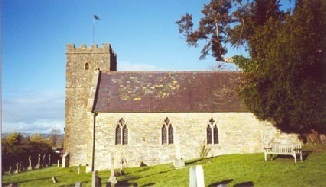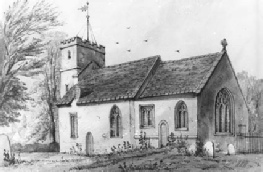



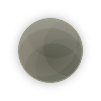

STOKE ST MARY AND DISTRICT HISTORY GROUP
HISTORY OF ST MARY CHURCH
The drastic restoration undertaken in that year greatly altered the internal appearance of the church, and destroyed much that might better have been left alone. The restorers almost doubled the sixe of the building by adding a south aisle, linkiing it to the old church by an arcade of arches made in a thirteenth century style. They also added a south transept and vestry, and a set of mock gothic windows modelled on a fourteenth century original which now overlooks the passageway to the vestry.
A new chancel arch was built in replacement of a ‘nondescript piece of masonry’ and to make the transformation complete the church was fitted out with red deal pews, oak choir stalls, and a Ham stone pulpit. In Febryary 1865 the church was opened for worship once more, the Revd F.B. Portman providing a suitable sermon the for occasion and the choir singing the responses from their new choir.
The thirteenth century tower fortunately escaped a suggested rebuilding, but the eighteenth century chalice and paten were not so lucky: in 1872, they were replaced by a modern set of medieval design.
A TOUR OF THE CHURCH
BUILDING HISTORY. When thirteenth century masons and carpenters finished work on St. Mary's Church, they left a simple structure consisting of chancel, nave, and tower. It is largely that thirteenth century building which the visitor sees today on approaching St. Mary's down the churchyard path: the plain, battlemented tower, in particular, stands almost unchanged after 700 years, and is one of very few entirely thirteenth century towers surviving in the county.
Though the interior of the church is dominated by work of later periods, striking reminders of the thirteenth century building also exist. They include an especially fine tower arch (unfortunately no more than a Victorian copy of the original), the shafts which support the chancel arch, and traces of the church's former roof line, visible high up on the west wall.
Almost every medieval church in Somerset benefited from the attention of fifteenth century builders, and St. Mary's Church, in its modest way, was no exception. It gained a new south porch, a Ham stone font (of which only the base is now original), and a variety of new windows: the chancel windows survive as fine examples of late fifteenth century workmanship; others of similar date in the nave were removed in 1864.
ST. ANNE'S CHAPEL. The chapel of St. Anne was created in the south aisle in 1972 during the incumbency of the Revd Arthur Stevens, and was inspired by the presentation to the church of a fine oak altar table. Designed by Mr. Arthur Holland, then church treasurer, and made by Mr. Arthur Matravers, a local woodcarver, the altar was given by Mrs. Agnes Fewings and her brother Mr. Sam Vile as a memorial to their parents James and Susan Vile. The chapel was completed by the addition of an altar rail, given as a memorial to his son Richard by Mr. Harry Adcock of Aplens. The rail came from the redundant church at Curland, and was reconstructed in its present form by Arthur Matravers.
THE ORGAN. The organ was brought from Stogursey church in 1978 through the generosity of Mr. John White as a memorial to his wife Ellaline who died in 1976. It was built in 1834, possibly by the firm of Flight and Robson, and in its original state could also be played as a barrel organ. It has six stops, including an unusual sesquialtera and cornet mixture, and has been restored by Osmond's of Taunton.
THE KNEELERS. As a result of a tapestry class held in the village hall in 1969, a group of volunteers, both men and women, began work re-
CHURCH PLATE. The present chalice and paten, based on a medieval design, were acquired by the church in 1872, and bear the simple inscription 'Stoke St. Mary'. A silver salver was presented to the church in 1943 under the will of Miss Maud E. V. Wynter who lived in the house called Tuckers. The church still possessed its earlier plate as late as 1870. The chalice bore the inscription 'Stoke St Mary 1759 Wm Philpott John Granslade Church-
THE BELLS. The church has a ring of five bells of which the oldest is the third. It was cast during the sixteenth century by Roger Semson of Ash Priors and is one of his well-
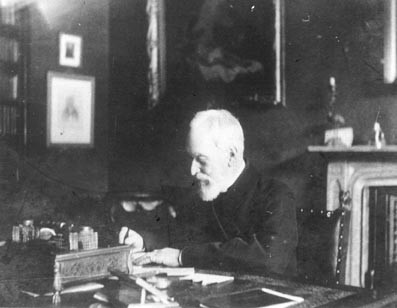
OTHER MEMORIALS.
The oldest memorial the church contains is the grave-
The stained glass window by the pulpit commemorates Elizabett Harman who died in 1898. Her father, Charles Harman of Stoke; St. Mary and Ruishton, became rich as the licensee of several London pubs, while his brother Henry remained at Stoke as tenant of Higher Broughton Farm. The family graves are in the churchyard.
The fine processional cross was originally given to Bathpool Church in memory of Gordon Parsons who died on active service in Italy in 1944. His brother, Mr. Dennis Parsons, arranged for the cross to be moved to Stoke St. Mary when the church at Bathpool closed.
Other valued gifts to the church include the splendid chair in the sanctuary presented in 1952 by Mrs. Hilda Loxton of Greenway Farm in memory of her parents James and Julia Barrington. The chair was made in the village, as were the two prie-
The lights on the choir stalls are a memorial to Mrs. Ruby Rowsell (1892-
THE CHURCHYARD. The churchyard has been used for burials since the Reformation and was enlarged in 1956 by the purchase of a plot of land on the south side. A garden of rest, with fine views to the Blackdown Hills, was created in 1971 for the burial of ashes, and has recently been enhanced by the addition of a seat in memory of Mervyn Roberts.
The churchyard gates were made in Taunton and presented by Mrs. Dorothy Hardwell in memory of her husband Fred Hardwell (1922-
The oldest memorial in the churchyard is the table tomb of Thomas Procter, who died in 1683. The Procters, ancestors of the Anderdon family of Henlade House, were prominent in Stoke St. Mary and Ruishton from the sixteenth century onwards, and were among numerous local families who suffered greatly in the Civil War. Thomas Procter lived on Stoke Hill, where his house was licensed as a Presbyterian meeting-
What's life. A vapovr. What is man.
A shaddow and ovr time a span.
An aged hvsband and his wife In hope of an eternal life
Here underneath this tomb do ly.
Reader look on and learn to dy.
HISTORY

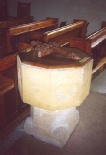
PRE RE-
THE NEW FONT
THE MODUS BOARD. The modus board was placed in the church in 1805 following a legal dispute. For many years it hung high up in the tower, but was recently restored and moved to its present position on the west wall. A modus was a money payment made to the rector instead of tithe payments in the form of corn, hay, and other produce. The modus system was favoured more by parishioners than clergy, who tended to lose by it, and when a rumour spread that Charles Russell, the rector, intended to do away with the moduses, a bitter quarrel resulted. The case reached the Court of Chancery before the villagers were satisfied that the moduses were out of danger.
The Owners and Occupiers of land in the Parish of Stoke St, Mary are entitled to the following
Modus or Customary charges in lieu of their tithes paid at Easter yearly.
For every acre of Grass in the Parish in lieu of the Tithe of Hay
For every calf reared in the Parish
For every Cow milked in the Parish in lieu of Tithes of Milk
For every Hogshead of Cider made in the Parish
For every Garden in the Parish
For the fall of every Colt in the Parish
For every score of Sheep fed in the Parish
but not shorn in the said Parish in lieu of
adjustment of Tithe and growth of Wool.
In 2014 a lavatory cubicle was installed where originally the organ had stood, the organ was turned through 90 degrees to face the congregation and moved further up the south Aisle. The pews in the south aisle were removed and replaced with free standing oak chairs. The altar table of the St Anne’s chapel was then re-
THE REYNTIENS WINDOWS
The three stained glass windows in the south aisle of St Mary’s Church are by the stained glass artist, Patrick Reyntiens OBE (b. 1925). He is regarded as one of the finest European stained-
The left-

William Lance, the curate, who oversaw the restoration work.
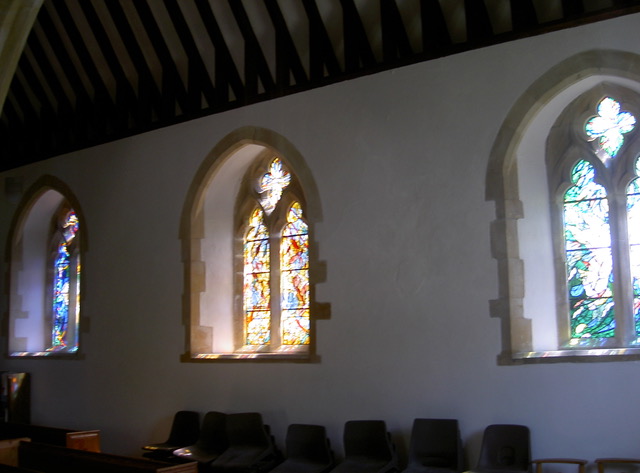
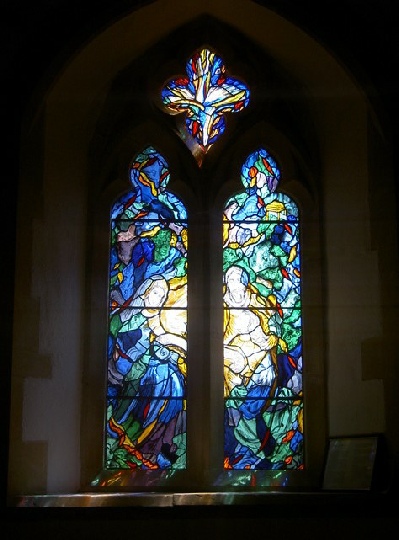
St Anne, with her husband St Joachim, teaching the Virgin Mary to read
St Anne is traditionally regarded as the mother of the Virgin Mary and was a very popular saint during the Middle Ages, especially in churches dedicated to St Mary. She is often shown teaching the Virgin Mary to read. The story was chosen for Stoke St Mary because the window formed part of the St Anne’s Chapel. The scroll which links the figures of St Anne and St Mary bears, in Hebrew, words from the Book of Isaiah, chapter 9: For unto us a child is born, unto us a son is given.
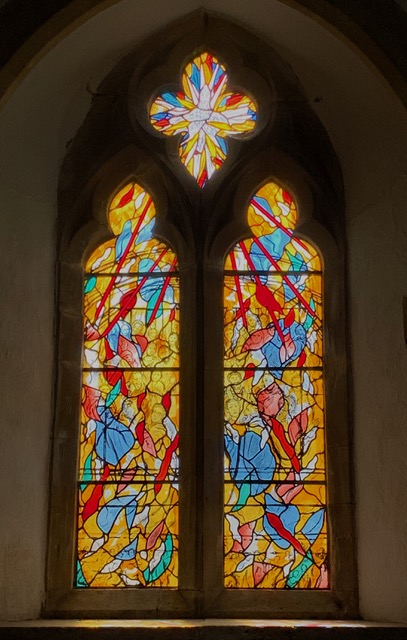
The Day of Pentecost
The central window is a dramatic depiction of the Day of Pentecost (Whitsun), as recorded in the Acts of the Apostles, chapter 2: And suddenly there came from heaven a sound as of a mighty wind…And there appeared unto them tongues parting asunder, like as of fire…And they were all filled with Holy Spirit…
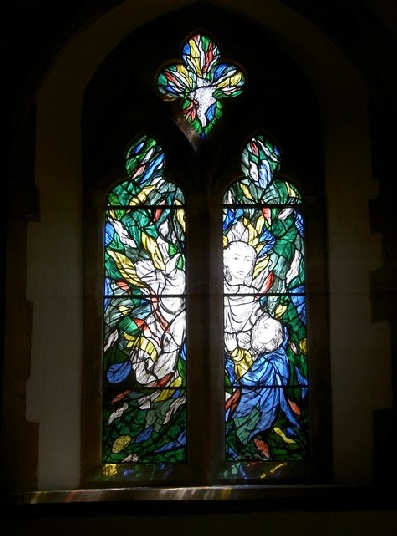
The Annunciation
The right-
2d
4d
3d
6d
2d
1/-
4d
Photographs kindly provided
by
David and Elizabeth Fothergill
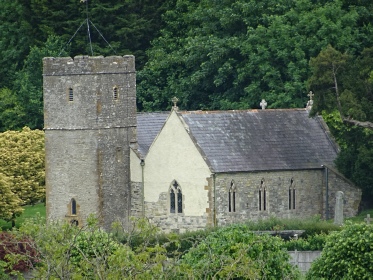
POST RE-
